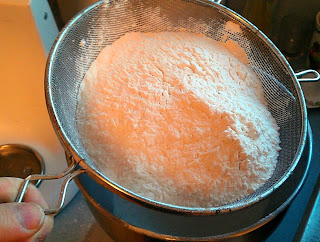A special welcome to new subscriber Magda. Great to have you here!
A special breakfast seems a perfect way to welcome the New Year. And if you love waffles, here’s one that’s not the usual kind: light, tasty Belgian Yeast-Risen Waffles.
What’s different about it? We often see what are being called Belgian Waffles. The problem is that those often are simply Belgian-style waffles that look like real Belgian waffles because they are large and have deep openings to hold toppings, but that are made with an American-style batter leavened with baking powder. A real Belgian waffle is made from a batter that is leavened with yeast, giving it a characteristic light texture. For this recipe, I’ve also used lemon or orange zest to give the waffles just a touch of tartness to complement the sweetness of the toppings, and beaten egg whites and some sparkling water to supplement that batter’s “fluff factor.” A bit of fat-free Greek yogurt enhances the flavor in a nice, healthy way. (Those last two ingredients are decidedly inauthentic for real Belgian waffles, but help keep the batter reduced-fat.)
So let’s heat up those waffle makers to ring in the new year right!
This recipe makes about eight 8” waffles.
Mix 1 package (0.25 ounce) of active dry yeast in 1 cup of warm (around 110 degrees) skim milk mixed with a teaspoon of honey or sugar. Let the mixture rest for about 10 minutes until creamy.
In a large bowl, sift together 3 cups all-purpose flour; 1 teaspoon salt; ½ cup sugar; ½ teaspoon cinnamon; and ½ teaspoon ground nutmeg.
Make a well in the dry ingredient mixture, and add 2 egg-substitute eggs; ¼ cup fat-free Greek yogurt; 1-1/2 teaspoon vanilla; ½ cup plus 1 tablespoon melted butter substitute; zest of one lemon or orange; and the yeast mixture.
Mix the wet ingredients, then stir into the dry ingredients while adding 1-1/4 cups of warm milk and ½ cup of room temperature sparking water to form a batter. Allow to rest for 5 minutes.
Add your favorite topping and a sprinkle of confectioner's sugar, and serve immediately, or keep warm in a 200 degree F oven until ready to add toppings and serve. (Click here for an easy recipe for a fresh fruit topping, along with a strawberry-rhubarb pastry that’s a lot of fun to make and eat! That recipe is for a strawberry topping; you can use the same recipe with different fruit, too. In the photo at the top, for example, I used blueberries, and kept them whole instead of pressing them with my hands.)
Wishing you all a happy, healthy and prosperous new year, a great start to which would be to visit again next week for another great-tasting, kitchen-tested recipe! Till then, stay well, keep it about the food, and always remember to kiss the cook, especially at midnight on December 31. ;-)






















































